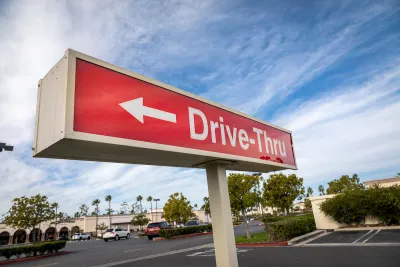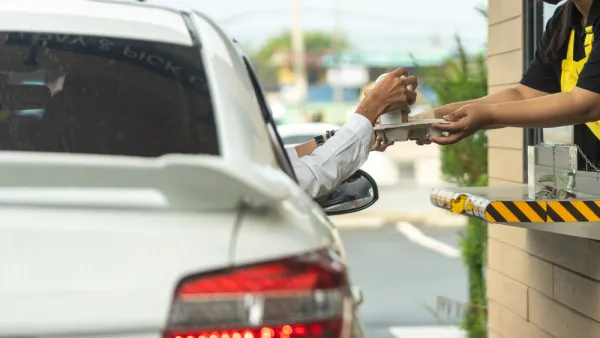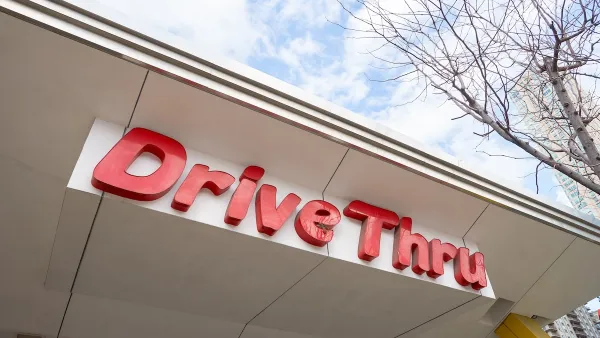Dining areas in many fast food restaurants are being replaced with added drive-thru lanes, another post-pandemic impact on our lives benefiting those with four wheels (or more).

“Maybe I’m lazy,” said the smiling University of South Alabama senior whose very happy photo inside her vehicle holding a Starbucks drink is most telling, “but it’s something about the car,” she tells a food reporter for The New York Times to explain why she “loves them so much she pulls into one at least eight times a week," referring to drive-thru facilities.
“Getting a meal through a car window began to define the nation’s food culture the moment the founders of In-N-Out Burger set up a two-way speaker in 1948,” writes Kim Severson who covers the nation's food culture for The New York Times on November 7.
[Related in Planetizen: “Drive-Thrus Banned at Birthplace,” August 4, 2010. Nate Berg reports on that drive-thru in Baldwin Park, California, and the city's attempt to address “‘in-car’ dining culture.”]
But the drive-through has never been as integral to how America eats as it is now.
And Severson has the data to prove it.
Drive-through traffic rose 30 percent from 2019 to 2022...Meanwhile, the number of people eating inside fast-food restaurants in the first half of 2023 fell by 47 percent from the same period in 2019. Drive-throughs now account for two-thirds of all fast-food purchases, according to a September report by Revenue Management Solutions.
Among the many reasons explaining the resurgence of drive-throughs this one was among the most surprising, what Severson called a “societal sea change:”
People emerged from the pandemic with less tolerance for interacting with strangers.
“These are all sorts of ways people are prioritizing safety. The drive-through mentality keeps people both physically and psychologically safe,” said Shelley Balanko, a social scientist and senior vice president with the Hartman Group, a research company that studies American eating patterns.
One of the many people interviewed in their vehicles in fast food parking lots for the piece perhaps said it best.
Before the pandemic, he would go inside restaurants like McDonald’s to eat. Now he sticks to the drive-through. “I got out of the habit,” he said. “I think I’m like a lot of people who just don’t necessarily like being social that much anymore.”
FULL STORY: Hungry (but Not for Human Contact), Americans Head for the Drive-Through

Analysis: Cybertruck Fatality Rate Far Exceeds That of Ford Pinto
The Tesla Cybertruck was recalled seven times last year.

National Parks Layoffs Will Cause Communities to Lose Billions
Thousands of essential park workers were laid off this week, just before the busy spring break season.

Retro-silient?: America’s First “Eco-burb,” The Woodlands Turns 50
A master-planned community north of Houston offers lessons on green infrastructure and resilient design, but falls short of its founder’s lofty affordability and walkability goals.

Test News Post 1
This is a summary

Analysis: Cybertruck Fatality Rate Far Exceeds That of Ford Pinto
The Tesla Cybertruck was recalled seven times last year.

Test News Headline 46
Test for the image on the front page.
Urban Design for Planners 1: Software Tools
This six-course series explores essential urban design concepts using open source software and equips planners with the tools they need to participate fully in the urban design process.
Planning for Universal Design
Learn the tools for implementing Universal Design in planning regulations.
EMC Planning Group, Inc.
Planetizen
Planetizen
Mpact (formerly Rail~Volution)
Great Falls Development Authority, Inc.
HUDs Office of Policy Development and Research
NYU Wagner Graduate School of Public Service



























